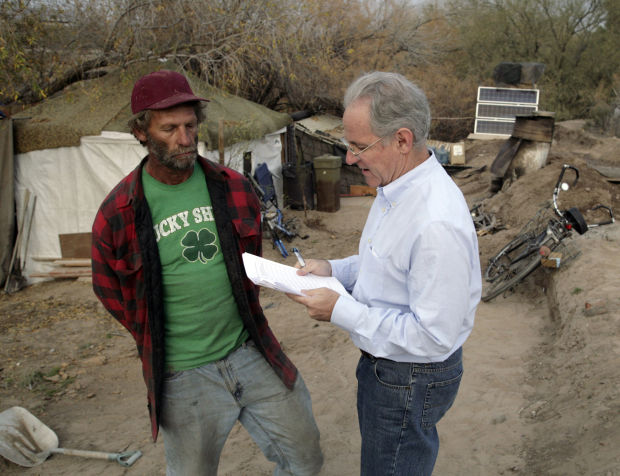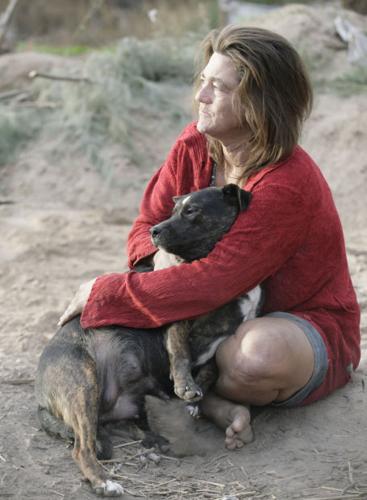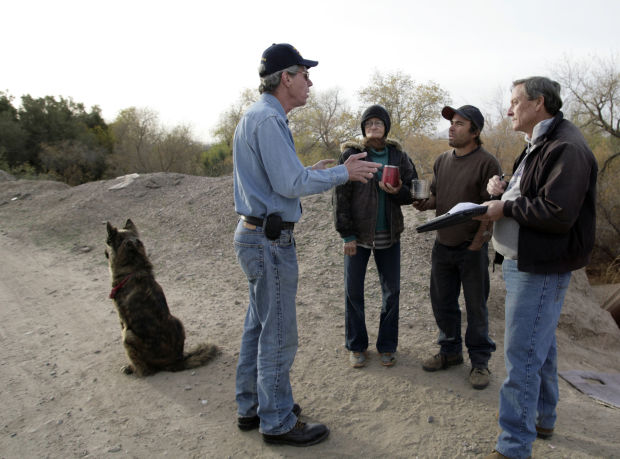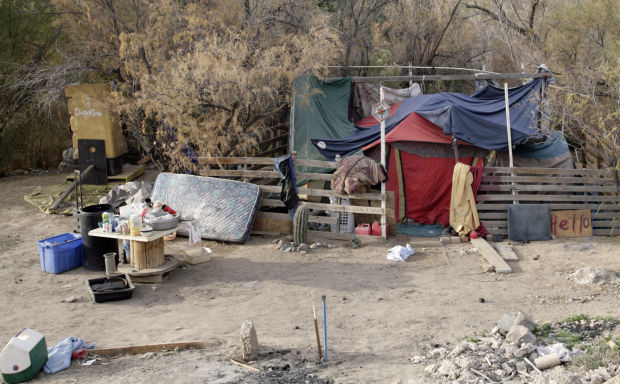Kathy Blevins, who has been homeless for the past four years, has carefully set up her campsite on a floodplain in north Tucson. Under the canopy of an old saltcedar tree, her site is marked by a fence of wooden pallets, adorned with a fake flower and a “private property” sign. A dream catcher hangs next to her tent.
Shortly after dawn on Friday, she feeds a campfire to ward off the morning chill and patiently answers the questions of volunteers seeking to quantify the homeless population in Tucson.
“I’m having a hard time out here,” says Blevins, 55, who is living alone in the camp until her husband gets out of jail in June.
More than 200 volunteers canvassed 30 sites on Thursday night and Friday — from shelters and churches, to desert campsites and street corners — as part of the annual Street Count, organized by the Tucson Pima Collaboration to End Homelessness. The count, required by the U.S. Department of Housing and Urban Development, generates homelessness estimates used to draw federal funding for homeless services. Advocates expect to receive more than $8 million in HUD funding for 2014.
To be counted, homeless individuals must agree to a brief interview about their circumstances and the services they need or are already using. Volunteers offered Jack-in-the-Box gift cards in exchange for the interviews.
“The data it provides to our community is really helpful in terms of community needs and how we can adjust our programming to hopefully serve people better,” said Ricardo Fernandez, homeless youth program services manager at Our Family Services.
Last year’s street count identified about 2,200 homeless people, including those sheltered and unsheltered. Nearly 400 of them were children.
The count significantly understates the homeless population, Fernandez said.
“The criteria HUD uses is very strict. If someone is homeless most of the year but they happen to stay in a motel that night, we can’t count them,” he says. “It doesn’t provide us the truest picture.”
On the floodplain just west of Interstate 10 near West Ruthrauff Road, Blevins’ tent site is one of many. Blevins says she lost her three convenience-store jobs after a heart attack sent her to the hospital and she could no longer do heavy lifting. She struggled to find a new job and couldn’t afford her rent anymore.
Cliff Wade, street outreach worker and veterans advocate with Old Pueblo Community Services, has been doing outreach work in this camp for four years. An Army veteran, Wade knows each of the 30 or so residents by name. Many greet him with a hug or a joke. Some are veterans struggling to get their benefits.
Wade notes he recently found a home for a man who had lived in the camp for 15 years.
“We’ve been having good success with this camp,” said Wade, who led the team of street-count volunteers Friday. “Most of my veterans are out of here, and now I’m working with those who are chronically homeless.”
Camp resident Mike Irvin, 55, has been homeless for a year and a half. After his mobile home burned down, Irvin said he wore out his welcome staying with friends.
“I just run out of friends,” said Irvin, an electrician by trade.
“I’ll retrain in anything. I’m ready to move out, move up,” he said.
But without a telephone or transportation, he says he’s struggled to get out of the homeless camp.
And for those with a criminal history, escaping homelessness can seem impossible: A felony drug conviction prohibits the offender from getting food stamps or other benefits. Many apartment managers won’t rent to felons, and employers reject their job applications, Wade says.
Tucson Mayor Jonathan Rothschild, who volunteered with the street count, says highlighting the problems of homelessness and poverty in Tucson is one of his priorities as mayor. Boosting social services and creating good jobs are crucial to addressing those issues, he said.
“Our police officers spend an inordinate amount of time dealing with social-services issues,” he said. “We need to do a better job recognizing who is across the street, in need, and doing what we can to help.”
Despite sometimes fearing for her safety, Blevins says she doesn’t want to leave the camp right now. She won’t abandon her cats or the belongings that she has stacked about the camp.
“I’m not going to do that,” she says. “This is my whole life.”







